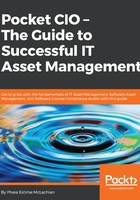
Are you ready for the evolution?
An honest, objective self-assessment is the best way to understand your maturity level of where you are right now in relation to ITAM, as well as where you want to go. Keep in mind that assessments of this type often benefit from the assistance of outside consultants, those whose interests coincide with the best interests of your organization. Lastly, remember that self-acceptance of the self-assessment results is really the start of your journey toward excellence in ITAM disciplines.
As an aid in your decision making, here is my adaption of the Process Maturity Model for IT Asset Management 2003 from Gartner, which is one of the most popularly cited maturity models across ITAM literature:

The following screenshot illustrates where your organization is at a point in time. You should define what stage you are when you begin, at a mid-point and at the end:

The following are a few more points to aid you in determining your organizations maturity level:
Stage 1: In the initial/adhoc stage, an organization is at what some would call the chaotic organization where:
- Capabilities are characteristic of individuals, not of the organization
- ITAM strategy, process, and responsibilities are not defined
- Technology solutions are not utilized
- There are no accurate inventories
- There are no specific vendors relationships developed for IT asset purchases
- There are no way of measuring exposures or risks
Stage 2: In the repeatable stage, an organization is at what some would call the reactive organization where:
- Processes and discipline exist to allow for repeatable results
- Informal IT asset request process
- Inventories are manually created
- The company's economies of scale are leveraged for IT asset purchases
- The discovery tool functions as the ITAM tool
Stage 3: In the defined stage, an organization is at what some would call the proactive organization where:
- The process is standardized across the organization
- An ITAM program is in place
- Policies, procedures, roles, and responsibilities have been communicated
- Service-level agreements are defined
- Process metrics are utilized
- The ITAM/SAM tool is integrated to auto-discovery
- The ITAM/SAM tool effectively integrates and reconciles to contractual and financial information, providing full transparency into the IT asset lifecycle
Stage 4: In the managed stage, the managed organization is at the point where:
- Risks are measured and managed quantitatively and aggregated on an enterprise-wide basis
- Integration with other technology management tools (for example, Service Desk, Change Management)
- Performance metrics against functional requirements are monitored
- Process improvements are identified, implemented, and can identify breaks in processes.
- Full lifecycle management, cradle to grave, including all implications for contractual and financial management, and asset relationship with service level management
- Ability to identify long-term opportunities for standardization and cost recovery
Stage 5: Optimized state:
- Organization is focused on continuous improvement
- Process metrics are well-established, consistently analyzed, and process/service level performance is linked directly with IT management performance
- Fines and violations of software and hardware agreements do not or rarely occur
- Executive dashboard available to show trends (improvement and efficiency)